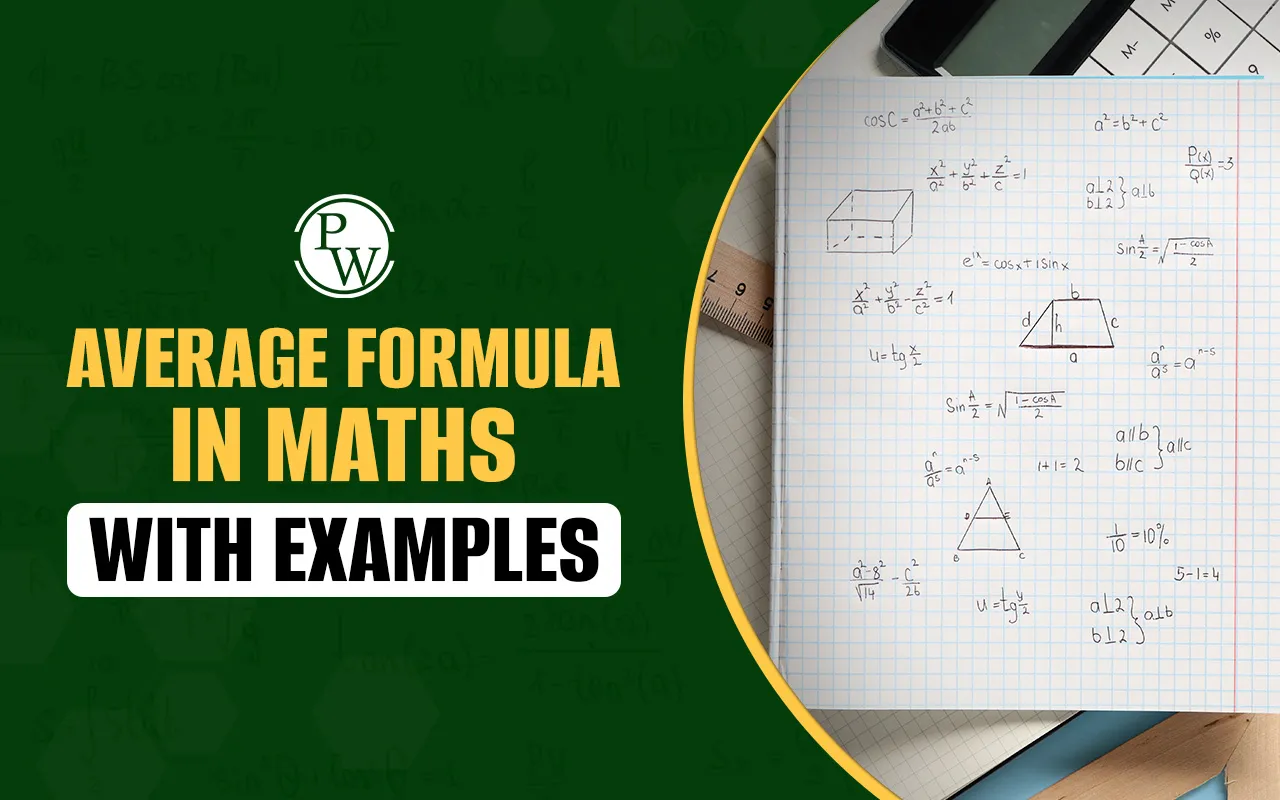

The average formula, also known as the arithmetic mean, is widely used to find the central value of a set of numbers. It is calculated by dividing the sum of all values by the total number of observations:
Average = (Sum of values) ÷ (Number of values)
This formula helps summarise data in a single representative number, making it easier to analyse and compare information. In this blog, we will understand the average formula meaning, types, applications, and solve examples to better understand how and when to apply it.
Read More: Dimensional Formula
What is Average in Maths?
In mathematics, the average (or arithmetic mean) is the central value of a data set. It is obtained by summing all the values in the set and dividing by the total number of values.
The average gives a quick idea of what a typical or central value in a group of numbers is. It simplifies data and is used across academics, finance, sports, and daily life.
Example:
Consider the marks scored by a student in 3 subjects:
Mathematics: 70, English: 75, Science: 65
To find the average:
Sum = 70 + 75 + 65 = 210
Number of values = 3
Average = 210 / 3 = 70
So, the student’s average mark is 70.
How to Calculate Average: Step-by-Step
To find the average in maths, add all the numbers in your list together, then divide the total by how many numbers you counted. This number is the average or mean. It gives a simple way to sum up a lot of information into one helpful number. Average is used everywhere, from classrooms to shopping.
Symbol of Average in Maths
In mathematics, the average is commonly represented by the symbol x̄, which is pronounced as "x bar". This notation is frequently used to indicate the average or mean of a sample in statistics and general mathematics.
In more advanced statistical contexts, especially when referring to the average of an entire population, the Greek letter μ (mu) is used.
x̄ is used when dealing with sample data and represents the arithmetic mean of the sample values.
μ is used when referring to the population mean, typically in probability theory and inferential statistics.
Both symbols are used to express the central value of a data set, with x̄ applied to samples and μ applied to populations.
Read More: Decimal Number System
Average Formula
The average formula helps you find the middle value of a group of numbers. To get the average, you add up all the numbers and then divide by how many numbers there are. It’s a quick way to see what the “typical” number is among a set. The formula is: Average = (Sum of all numbers) ÷ (Total number of numbers).
Average Formula in Maths with Example
The math average formula is simple and clear. Just add all your numbers together and divide by how many numbers there are. This process tells you the mean or average value, which is helpful for comparing different sets. It’s one of the most common formulas used in basic mathematics.
What is the Average Formula?
The formula for the average is:
Average = (Sum of all values) / (Number of values)
This is the most basic and widely used version of the average formula in maths.
Example:
You buy 5 books costing ₹120, ₹150, ₹130, ₹140, and ₹110.
To calculate the average price:
Sum = 120 + 150 + 130 + 140 + 110 = ₹650
Number of books = 5
Average = 650 / 5 = ₹130
So, the average price of the books is ₹130.
Read More: a²+b²+c² formula with Examples
Types of Average in Maths
The concept of average in mathematics extends beyond the basic arithmetic mean. Depending on the nature of the data and the context of the problem, different types of averages are used. Below are the four most commonly used types of averages, along with their formulas and examples.
1. Arithmetic Mean
The arithmetic mean is the most commonly used form of average and is often what people refer to when they use the word "average". It is calculated by dividing the sum of all values by the number of values.
Arithmetic Mean Formula:
Arithmetic Mean = (x₁ + x₂ + ... + xₙ) ÷ n
Example:
Find the average of 10, 15, and 20.
Sum = 10 + 15 + 20 = 45
Number of values = 3
Average = 45 ÷ 3 = 15
2. Weighted Average
The weighted average is used when different values in a data set contribute unequally to the final result. Each value is multiplied by its assigned weight, and the total is divided by the sum of the weights.
Weighted Average Formula:
Weighted Average = (w₁x₁ + w₂x₂ + ... + wₙxₙ) ÷ (w₁ + w₂ + ... + wₙ)
Where:
x₁, x₂, ..., xₙ are the values
w₁, w₂, ..., wₙ are the corresponding weights
Example:
A student scores 80 in theory (70% weight) and 90 in practical (30% weight).
Weighted Average = (80 × 0.7) + (90 × 0.3) = 56 + 27 = 83
This type of average is commonly used in academic grading and financial analysis.
3. Geometric Mean
The geometric mean is used to find the average of values that are multiplied together or that grow exponentially. It is calculated by taking the nth root of the product of n numbers.
Geometric Mean Formula = ⁿ√(x₁ × x₂ × ... × xₙ)
Example:
Find the geometric mean of 2 and 8.
Product = 2 × 8 = 16
Geometric Mean = √16 = 4
This type of average is commonly used in fields such as finance (e.g., interest rates) and population studies.
Read More: How to Find the Angle of a Triangle
4. Harmonic Mean
The harmonic mean is used when the data consists of rates or ratios, such as speed, efficiency, or density. It is calculated by dividing the number of values by the sum of the reciprocals of the values.
Harmonic Mean Formula = n ÷ [(1/x₁) + (1/x₂) + ... + (1/xₙ)]
Example:
A car travels 60 kilometres per hour on the way to a destination and returns at 40 kilometres per hour.
Harmonic Mean = 2 ÷ [(1/60) + (1/40)]
= 2 ÷ [(40 + 60) ÷ (60 × 40)]
= 2 ÷ [100 ÷ 2400] = 2 ÷ (1/24) = 48 km/h
The harmonic mean is ideal when dealing with quantities defined in relation to another unit, such as "per hour" or "per unit distance".
How to Calculate Average
To calculate the average, first add all the numbers together to get the total. Next, count how many numbers there are in your group. Finally, divide the total sum by the number of numbers. The answer you get is the average.
Average Solved Example
-
The scores obtained by a student in five subjects are 72, 85, 90, 76, and 88. Find the arithmetic mean of the scores.
Solution:
Step 1: Add all the scores
Sum = 72 + 85 + 90 + 76 + 88 = 411
Step 2: Count the number of subjects
Number of values = 5
Step 3: Use the average formula
Arithmetic Mean = Total Sum ÷ Number of Values
= 411 ÷ 5 = 82.2
The arithmetic mean score is 82.2
-
A student scored 65 marks in Mathematics, 75 in Physics, and 60 in English. The respective weights (credits) for these subjects are 4, 3, and Find the weighted average score.
Solution:
Step 1: Multiply each score by its weight
Math: 65 × 4 = 260
Physics: 75 × 3 = 225
English: 60 × 2 = 120
Step 2: Add all the weighted scores
Total Weighted Score = 260 + 225 + 120 = 605
Step 3: Add the weights
Total Weights = 4 + 3 + 2 = 9
Step 4: Use the weighted average formula
Weighted Average = Total Weighted Score ÷ Total Weights
= 605 ÷ 9 ≈ 67.22
The weighted average score is approximately 67.22
-
Find the geometric mean of the numbers 3, 6, and 12.
Solution:
Step 1: Multiply all the values
Product = 3 × 6 × 12 = 216
Step 2: Count the number of values
n = 3
Step 3: Take the cube root (³√) of the product
Geometric Mean = ³√216 = 6
The geometric mean is 6
-
A train travels a distance of 120 km to a city at a speed of 60 km/h and returns at a speed of 40 km/h. Find the average speed for the entire journey using the harmonic mean.
Step 1: Use the harmonic mean formula for two values
Harmonic Mean = 2 × x × y ÷ (x + y)
Here, x = 60, y = 40
Harmonic Mean = (2 × 60 × 40) ÷ (60 + 40)
= (4800) ÷ (100) = 48 km/h
The average speed for the round trip is 48 km/h.
Also read: Divisibility Rule of 11 with Examples
Real-Life Applications of Average Formula
Below are some common fields where the average formula is widely used:
Academics: Used to compute average marks, GPA, and assess student or class performance.
Business and Finance: Helps track average sales, profits, expenses, and investment returns.
Sports: Used in calculating player stats like batting average, goals per match, or points per game.
Weather Forecasting: Averages summarise temperature, rainfall, or humidity over time.
Healthcare: Average heart rate, recovery time, and patient statistics aid in treatment planning and medical research.
Help Your Child Master Mental Math with CuriousJr
Does your child find math frustrating or lose interest when faced with long and tricky calculations? As problems become more complex, many children struggle with confidence, especially if their mental calculation skills are not well developed.
CuriousJr’s Mental Math Online Classes support children in strengthening mental math skills through engaging sessions, simple methods, and regular practice. Children learn to solve problems quickly and accurately without relying on fingers or calculators.
These classes include live instruction, two-teacher support, and help with homework to keep children focused and motivated. As their speed and understanding grow, so does their confidence and enjoyment of math. Book a demo class today.
Average Formula FAQs
What is the average formula in mathematics?
When should we use the average formula?
What is the difference between average and weighted average?
Can the average be a decimal or a negative number?
How is the average formula applied in daily life?













